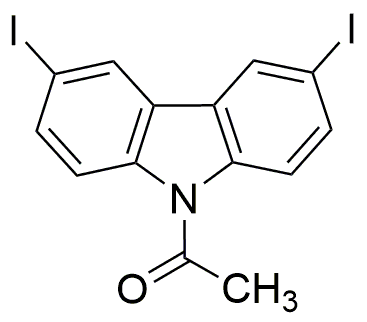9-Acetyl-3,6-diiodocarbazole is widely utilized in research focused on:
- Organic Electronics: This compound is used in the development of organic light-emitting diodes (OLEDs), enhancing the efficiency and color range of displays in devices like smartphones and televisions.
- Photovoltaic Cells: It serves as a key material in organic solar cells, contributing to improved energy conversion efficiency, making solar technology more accessible and sustainable.
- Fluorescent Probes: The compound is employed in biological research as a fluorescent probe, allowing scientists to visualize cellular processes with high specificity and sensitivity.
- Medicinal Chemistry: Its unique structure makes it a candidate for drug development, particularly in targeting specific cancer cells, potentially leading to more effective treatments with fewer side effects.
- Material Science: Used in the synthesis of advanced materials, it aids in creating polymers with enhanced thermal and mechanical properties, beneficial for various industrial applications.
Informations générales
Propriétés
Sécurité et réglementation
Applications
9-Acetyl-3,6-diiodocarbazole is widely utilized in research focused on:
- Organic Electronics: This compound is used in the development of organic light-emitting diodes (OLEDs), enhancing the efficiency and color range of displays in devices like smartphones and televisions.
- Photovoltaic Cells: It serves as a key material in organic solar cells, contributing to improved energy conversion efficiency, making solar technology more accessible and sustainable.
- Fluorescent Probes: The compound is employed in biological research as a fluorescent probe, allowing scientists to visualize cellular processes with high specificity and sensitivity.
- Medicinal Chemistry: Its unique structure makes it a candidate for drug development, particularly in targeting specific cancer cells, potentially leading to more effective treatments with fewer side effects.
- Material Science: Used in the synthesis of advanced materials, it aids in creating polymers with enhanced thermal and mechanical properties, beneficial for various industrial applications.
Documents
Fiches de données de sécurité (FDS)
La FDS fournit des informations de sécurité complètes sur la manipulation, le stockage et l’élimination du produit.
Spécifications du produit (PS)
Le PS fournit une description complète des propriétés du produit, notamment sa composition chimique, son état physique, sa pureté et les exigences de stockage. Il détaille également les plages de qualité acceptables et les applications prévues du produit.
Certificats d'analyse (COA)
Recherchez des certificats d'analyse (COA) en saisissant le numéro de lot du produit. Les numéros de lot et de lot se trouvent sur l'étiquette d'un produit, après les mots « Lot » ou « Lot de fabrication ».
Numéro de catalogue
Numéro de lot/série
Certificats d'origine (COO)
Ce certificat d'exploitation confirme le pays dans lequel le produit a été fabriqué, et détaille également les matériaux et composants utilisés et s'il est issu de sources naturelles, synthétiques ou autres sources spécifiques. Ce certificat peut être requis pour les douanes, le commerce et la conformité réglementaire.
Numéro de catalogue
Numéro de lot/série
Fiches de données de sécurité (FDS)
La FDS fournit des informations de sécurité complètes sur la manipulation, le stockage et l’élimination du produit.
DownloadSpécifications du produit (PS)
Le PS fournit une description complète des propriétés du produit, notamment sa composition chimique, son état physique, sa pureté et les exigences de stockage. Il détaille également les plages de qualité acceptables et les applications prévues du produit.
DownloadCertificats d'analyse (COA)
Recherchez des certificats d'analyse (COA) en saisissant le numéro de lot du produit. Les numéros de lot et de lot se trouvent sur l'étiquette d'un produit, après les mots « Lot » ou « Lot de fabrication ».
Numéro de catalogue
Numéro de lot/série
Certificats d'origine (COO)
Ce certificat d'exploitation confirme le pays dans lequel le produit a été fabriqué, et détaille également les matériaux et composants utilisés et s'il est issu de sources naturelles, synthétiques ou autres sources spécifiques. Ce certificat peut être requis pour les douanes, le commerce et la conformité réglementaire.


